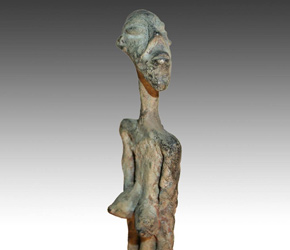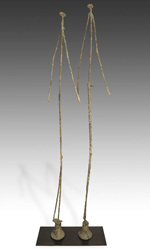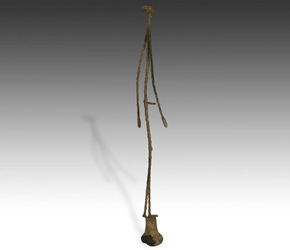Dogon Star Gazers
 |
|
The Dogon people have resided in central Mali along the Bandiagara escarpment since they migrated there sometime in the 15th century. They are known for their hospitality and their cultural heritage, which has been recorded by the production of meaningful artwork since the culture was first established. Consequently, each Dogon village supports artisans such as sculptors, weavers and blacksmiths.
 |
|
Small and large altar figures are an integral part of the Dogon artistic heritage and are regularly produced by the blacksmiths, who are highly empowered individuals. It is the blacksmith who carves ancestral and magic figures, who casts protective amulets, who forges objects, and who instills magic into objects commissioned by various societies or associations. Regardless of the type of piece being created, during its creation the attention of the blacksmith is almost universally placed on the "ancestors" as much as the object itself.
Skilled Dogon blacksmiths are capable of sculpting and casting figures and objects using methods such as the lost wax process; and equally capable of forging objects from raw iron ore and other metals. In reality, the forge or fire is the center of focus of the blacksmith's work. It is in the "fire of the forge" that the metal is heated to incandescent red, orange, yellow and white heats, for only at these highly elevated temperatures can iron be made plastic enough to be shaped and formed. From depictions of ancestors to equestrian riders, seated figures and domestic animals, Dogon blacksmiths are masters of cast bronze sculptures. They are also expert at hammering unique figures out of iron ore in forms which appear to be gazing at the heavens. Such pieces are known as "stargazers" and are usually created in male and female pairs.
 |
|
The mythology surrounding the Dogon creation myth is very complex, and there is much debate within Dogon society of its validity. Two French anthropologists by the names Marcel Griaule and Germaine Dieterlen visited the Dogon in 1931 and documented that the Dogon believed they were visited by gods known as the Nommo thousands of years ago. It was then that they obtained their deep knowledge of agriculture and farming, which to this day is the reason they have survived so well on the desolate Bandiagara Escarpment. According to Dogon legend, the Nommo came from a planet orbiting around an invisible star obscured by Sirius, the brightest star in the night sky. The Dogon have held this belief since antiquity. This may be of little interest to anybody, except it turns out that there is an invisible star in the Sirius system, which was only discovered by western scientists in 1978. The discovery of the star known as Sirius B, a small white dwarf star, raised a simple question: how could a people with no astronomical devices know so much about an invisible star, a star they have celebrated in ceremonies since the 13th century?
While there is much debate among native Dogon about how they were created, there is general agreement that visitors came from 'up there' possessing powerful and advanced knowledge. To this day much of their art relates to the untold mystery of what may come from the stars, something all humans relate to, regardless of origin, race or religion. Star gazers refer to this mystery. They truly capture the abstract yet traditional qualities of the best of African art. The stargazers celebrate the union of male and female and are given in celebration of matrimony, but it is their heaven-bound glances, alluding to questions all humans pose when we look to the stars, that make them unforgettable.